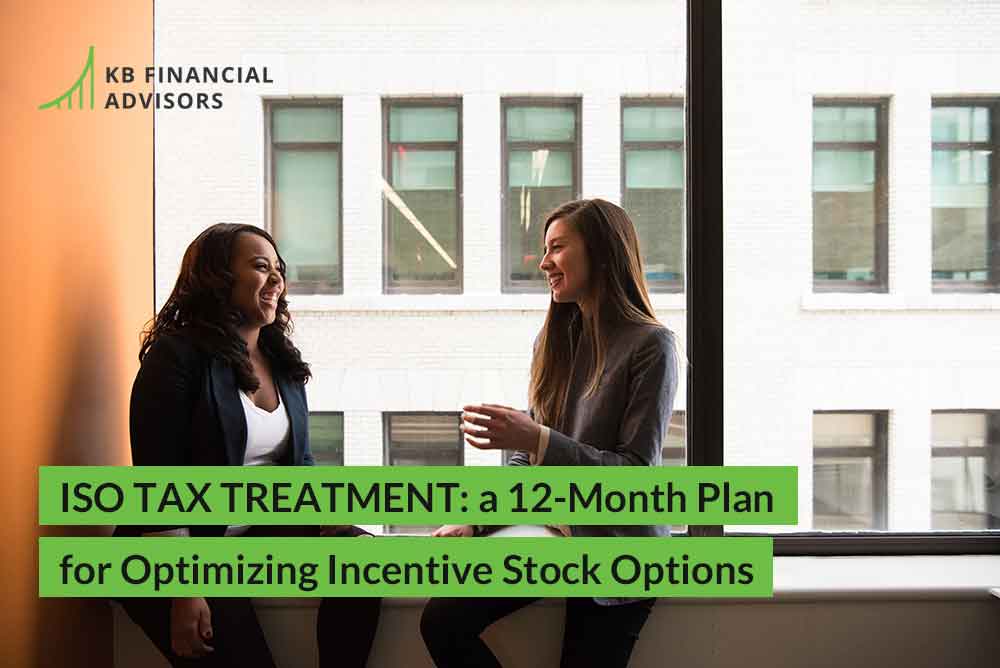ISO tax treatment can be a headache. ????
Seriously.
If you’ve got incentive stock options with your company, you’ll know they come with their own little set of tax rules.
Alternative minimum tax? Minimum tax credit? The difference between stocks held more or less than one year?
It can be a lot to remember, and since ISO tax treatment is so different from any other type of asset or income, planning in advance can be a huge time and money-saver.
Fortunately, because of the way our tax years are set up, there are certain things you can do in each quarter of the year to make the most of your incentive stock options. When you have a basic plan in place, you don’t have to deal with all the mental stress, and can just do one or two things every few months to stay on top of the game.
These quarterly ISO check-ins happen naturally after a company goes through an IPO, because the business will have to publish quarterly earnings reports. But even when a company is still private, thinking in quarters will set you up for success after the IPO happens.

An Overview Of What We’ll Cover:
Quarter One (January – March)
- Exercise, Exercise, Exercise
Quarter Two (April – June)
- For Post-IPO Companies
Quarter Three (July – September)
- For Pre-IPO Companies
Quarter Four (October – December)
- Execution & Selling
Quarter One: Exercise, Exercise Exercise
By far, January is the best month to exercise incentive stock options. But if you don’t quite hit the January 31 deadline, the first quarter of the year is a great time to exercise ISO.
Why?
Taxes are due every year on April 15.
So, when you exercise your ISO before the end of March, you don’t have to pay any taxes on them–or on the Alternative Minimum Tax (AMT) if you triggered it–until the following year. ????????♂️
But this isn’t just about procrastinating payments. If you do trigger the AMT by exercising ISO, if you hold onto the resulting shares for one year or more, they qualify as long-term capital gains stock. This means they’re taxed at a lower rate than if you’d exercised and held them for less than a year before selling.
Putting two and two together, if you do trigger the AMT by exercising some ISO in the first quarter of the year, you’ll be able to hold those shares for a year, and sell what you need to sell at a lower tax rate to pay the AMT before it’s ever owed.
Even if you don’t use this strategy, you’d still have the rest of the year to change your mind on what to do, putting yourself in a better strategic position.
The most important thing, though, is to decide your strategy for Q1 and execute it. Do you want to exercise all the ISO you have available? Exercise just enough so you don’t trigger the AMT? Or somewhere in between?
Determining Your Q1 Strategy for Exercising ISO
Before you decide on a final strategy, you’ll need to get a grip on your tax situation and what kind of wiggle room you have for exercising ISO this year.
Using last year’s tax return and your most recent pay stub, you can see what tax bracket you’re in and what kind of wiggle room you have to exercise ISO before triggering the AMT. Plus, if you decide to exercise more than that and trigger the AMT anyway, you’ll know how much you’ll owe. (Check out this post for more depth on how ISO & AMT work together.)
Then, once you’ve got an idea of your taxes, you can use your bargain element to figure out exactly how much to exercise in Q1. (The bargain element is the difference between your exercise price, and the fair market value, or FMV, at the time of exercise.)
Bargain Element Per ISO = FMV – Exercise Price
This bargain element is what gets reported on your tax return, and is what has the power to trigger the AMT. Using your tax projection, you’ll be able to figure out how low you need to keep this bargain element amount to not trigger the AMT.
Number of ISO to Exercise = AMT Limit Amount ÷ Bargain Element Per ISO
Quarter Two: Planning for Post-IPO Companies
If you work for a company that’s already gone through an IPO, Quarter Two (April – June) is the time to monitor the stock prices, especially as each new trading window opens.
If the price of your stock keeps rising on the ISO you exercised in Q1, hold.
But if you notice the price starting to fall, you need to do a few things:
First, calculate your break-even price. Know exactly how low the stock price can fall before you lose the advantage of waiting one year to sell.
This is more than just a “money you spent vs. money you’ll make” kind of calculation. You’ve also got to consider ISO tax treatment and whether or not you’d be in a better position to sell now and trigger less taxes than the AMT, even though you’d be paying a higher tax rate in short-term capital gains.
It can be a complex equation and hard to figure out, which is why we recommend working with a financial professional to help you get things just right.
Second, if it’s better to go ahead and sell now because the prices are down… you’ll need to sell.
When you sell in the same calendar year you exercised, it eliminates AMT… so even if you triggered by exercising in January, if you sell those same shares now, you won’t have to pay it next April.
If you decide to hold in Q2, repeat this decision process in Q3.
Quarter Three: Planning for Pre-IPO Companies
If your company hasn’t gone public yet, Q3 (July – September) is the perfect time to evaluate any tender offers or private sales available.
Just because your options aren’t as liquid as those of a post-IPO company doesn’t mean you should overlook opportunities to cash them out. Any potential you have for making your assets more liquid is potential for improving your financial future.
Depending on what’s available to you right now, you could use this liquidity opportunity to:
- Lower the AMT you’ll owe from exercising in Q1.
- Increase the amount of ISO you can exercise without triggering AMT for next year, even still.
Sell some shares so you can create more cash to exercise more of your options.
Quarter Four: Execution & Selling
In Q4 (October – December), your focus is on executing anything that needs to be done before the December 31 year-end deadline. It’s your last chance to change your profitability and ISO tax situation for that calendar year.
This is especially important if you’re considering selling to eliminate the AMT: if you hold past December 31, that amount you owe on AMT will be set, and you’ll have to pay it come April 15.
Owing AMT is not necessarily a bad thing, especially if your stock price is doing well and you’ll be able to sell for a profit after the one-year mark, but you shouldn’t ignore these calculations.
But no matter what you’re thinking about doing before the end of Q4, it’s important to update your tax projections. When you did the tax projection back in Q1, it was a good guess… but now a year has passed and there’s a good chance something’s changed.
You could’ve gotten a raise & been elevated into a new tax bracket. Or you could have more wiggle room than you expected to exercise ISO before triggering the AMT.
But now, with just one or two months left in the year, less change is going to happen, and you’ll have a clearer picture of what to expect in April. Because of this, Q4 is a time to run the numbers again, just like you did in Q1. And, if there are any more moves you need to make, make them before December 31.
Stay on Top of Your ISO + Tax Plans With a Trusted Financial Advisor
If there’s one thing the KB Advisors team can do in their sleep, it’s plan ISO exercising & selling around individual situations and current stock prices. Like, we’re really good at it and have helped hundreds of clients do it over the past 18 years.
So if you’d like some help making the most of your ISO and other company stock options you have, book a call with one of us. We’d be happy to talk to you.



